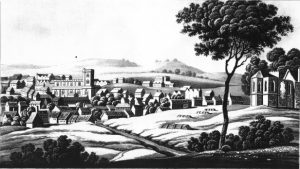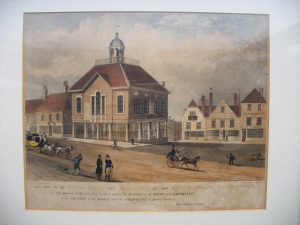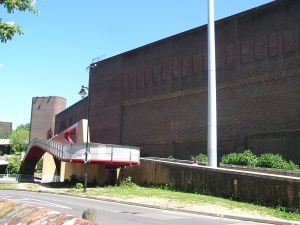Basingstoke and its Contribution to World Culture – a lecture by Rupert Willoughby -November 13th.
We were all fascinated to hear how Rupert was going to address the title of this talk. He began by saying that Basingstoke is a phenomenon and is one of the most derided towns- with nicknames that include ‘Boringstoke’ and ‘Basingrad’. In 2004 a PR campaign was launched to improve its image. Rupert then identified some of the reasons why the town is notorious, including its succession of pointless roundabouts and its huge boring and seemingly pointless wall – known as the ‘Great Wall of Basingstoke’
It is often erroneously assumed that Basingstoke is a post war creation, but Rupert informed us that this is not so- it appears even in the Domesday Book.
Cosimo, 3rd. Duke of Tuscany visited Basingstoke and took with him Magalotti to record their journey with sketches and writings.  Magalotti writes that they ‘ set out to explore it on foot but its wretchedness prevented them’
Magalotti writes that they ‘ set out to explore it on foot but its wretchedness prevented them’
In 1830 there were two or three working farms right in the middle of town and in a painting of Basingstoke in 1831 it appears as quite an attractive town. 
In the Highway and Byway book Basingstoke is described as ‘a town to be hurried through’
In 1966 it was written of as ‘a town devoid of style though John Betjeman wrote that Basingstoke typified England at its best.
Basingstoke’s main problem is that it was developed in a coarse and brutal manner as a show piece in the south of England. There was a lack of post war planning and Council Housing was the key. Sir Patrick Abercrombie – a very successful 20th Century architect was approached by the government to develop ‘The Greater London Plan’ to move 1.330.000 Londoners to new towns like Stevenage and Harlowe and and for it to be a show piece in the South of England. Town planners at this time were very left wing and their theory was that council housing and mass production brought about a middle class structure for all. Hook was the original choice for this development but members of the Royal family objected as it would take up a favourite hunting area. Tragically the plan involved destroying many historical and interesting buildings in order to create a raised concrete monstrosity containing shopping malls and offices and but no trees.
So where once quaint cottages, interesting homes such as those of Jane Austen and her relatives and grand houses of families like the Merton family (who founded Merton College ) and Thomas Burberry ( inventor of the gabardine raincoat ) had once stood, there now were soulless concrete structures.

